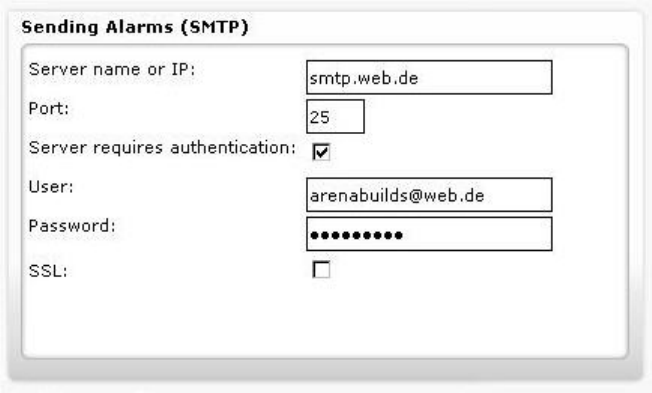
USER GUIDE ARENA/ RANGER
83 EN2Z-0906GE51 R0708
check this by selecting Connect to / Show all connections from the Windows
Start menu. Then open the properties of the connection.
Sending Alarms (SMTP)
NOTES:
– The SMTP (Simple Mail Transfer Protocol) is preferentially used for
sending/forwarding emails.
– To get information about the SMTP settings, go to the web site of the
local ISP, invoke the Help function and search for the required
information. The search and location where the information can be found,
may differ from ISP to ISP. If no information can be found in the Help,
contact the ISP directly.
a. In Server Name or IP, enter the address of the SMTP server (name or IP
address) you want to use to forward alarms e.g. “smtp.web.de”.
b. In Port, you must change the port used to send/forward emails via SMTP if
your ISP uses another port than the default port 25. Change it accordingly, if
necessary.
NOTE:
It may happen, that an anti-virus software may block the port 25 which is
necessary for sending emails. In this case, you must change the
configuration settings of the anti-virus software in order to allow ARENA
forwarding alarms (see Anti-Virus Software Tools and Ports in the
”Security” chapter of the ARENA / RANGER Installation Guide, EN1Z-
0906GE51).
c. Check Server requires authentication and enter User and Password, if
the Email-Server requires authentication.
d. Uncheck Server requires authentication if the Email-Server does not
require authentication
e. Required Authentication protects mailboxes by user name and password.
f. Check SSL, if the SMTP server uses the SSL (Secure Sockets Layer)
standard for the data transmission.
Receiving Responses (POP3)
POP3 (Post Office Protocol) is a client/server protocol for the communication
between an email program on an individual user PC and a mail server in the
internet hosting the mailbox of the user by an ISP (internet service provider). Via
POP3, emails will be sent from ISP mailbox to the user PC.
NOTE:
To get information about the POP3 settings, go to the web site of the local ISP,
invoke the Help function and search for the required information. The search
and location where the information can be found may differ from ISP to ISP. If
no information can be found in the Help, contact the ISP directly.
